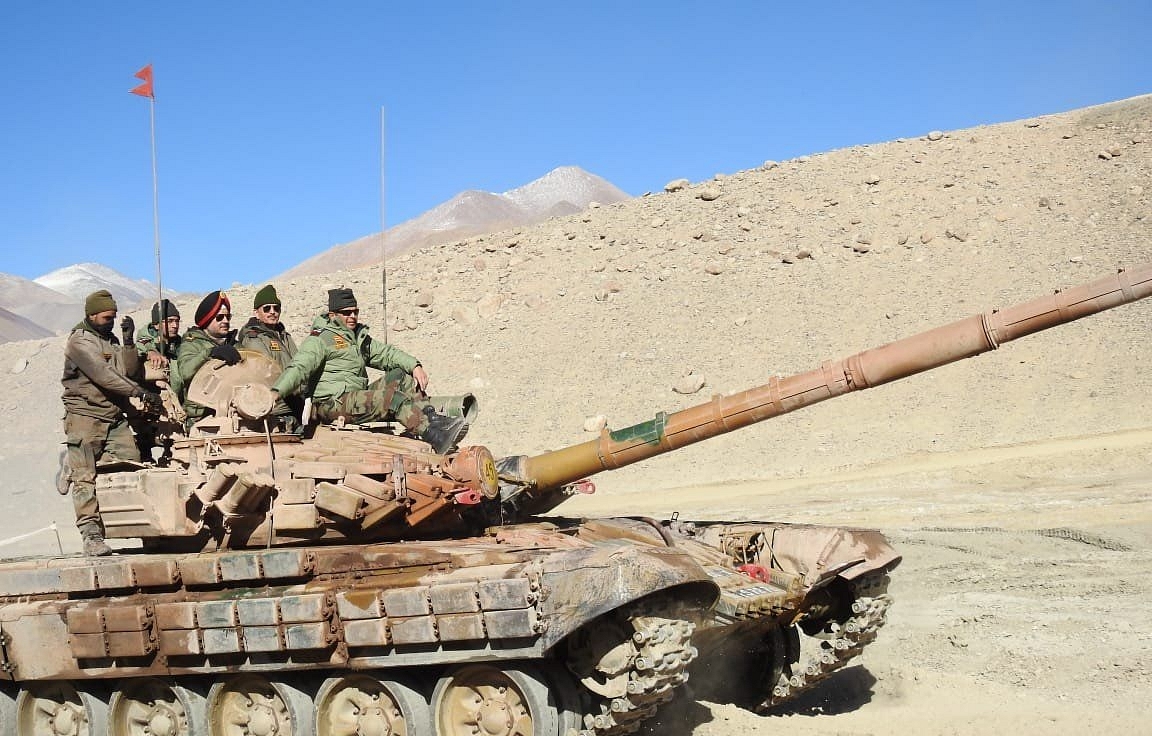Defence
Area Domination, Recon, Deep Reserves And Logistics - How Indian Army Will Tackle Third Summer Deployment Against China In Ladakh

Representative Image - Lieutenant General Ranbir Singh, Former Chief of Army’s Northern Command, on a tank in Ladakh. (Northern Command Indian Army/Twitter)
The Indian Army's stand off against the Chinese forces in Ladakh will now enter the third consecutive summer of forward deployment of combat units.
According to reports, the Army's summer strategy in eastern Ladakh will involve a balanced defense, deep reserves, daily aerial reconnaissance, patrols, and validation exercises along the LAC.
India and China are continuing their military standoff for the third summer in eastern Ladakh. Although many of the friction points, such as Galwan Valley, north and south banks of Pangong Tso, and the Gogra-Hot Springs area, have been resolved with buffer zones in the past three years, legacy issues like Depsang Plains and Demchok still remain unresolved.
The External Affairs Minister, S Jaishankar, recently termed the situation at the eastern Ladakh's LAC "very fragile" and "quite dangerous" in military assessment. He had previously referred to it as "unstable" or "abnormal."
The summer strategy of the force aims to enhance tactical dominance along the LAC, exhibit strategic strength, and enhance the comfort of troops deployed in the region, state officials. Over 50,000 troops from India and China have been positioned in Ladakh since the standoff began in 2020.
The LAC and buffer zones will be closely monitored as troops shift to a summer posture in eastern Ladakh, according to a senior official. Adequate troop strength will be kept in reserve to deal with unforeseen incidents.
To avoid confrontations on the LAC, India will conduct validation exercises like regular reconnaissance through unmanned aerial vehicles and helicopters. Standalone cameras will be set up for areas that can't be patrolled regularly. Existing protocols will be followed, and the focus will be on mobilisation of reserves and logistics, as India conducts several validation exercises over the next few months.
LAC dominance will persist through new posts within 1 km of the border and battalion locations closer to the main axis, including buffer zones.
The statement, "There are substantial reserves at the brigade and battalion levels. Local reserves at the formation levels have already been put in place and brigades from strike corps will continue to be deployed in rotation," was made by an unnamed second official as reported in a secondary source.
Divisions will acclimate, train and rotate their brigades regularly, with initial induction to occur as soon as possible, according to an official.
Officials plan to reduce the Rashtriya Rifles to four companies from six. To make up for the resulting shortfall, additional RR battalions from J&K may be inducted in Ladakh. Currently, around six battalions of this uniform force are deployed in Ladakh, as of 2021.
More RR battalions in Ladakh may require additional sector headquarters to oversee them, according to the second official.
According to an official, deploying more RR battalions would help reduce the turnover of regular infantry battalions with extended high-altitude tenures and would complement the reduction of forces in J&K.
Officials plan to enhance repair and recovery support for armored vehicles to cope with wear and tear. They aim to increase efficiency in logistics and replenishment processes from both forward and rear bases with better road infrastructure in the coming year.
Managing road space is a top priority as passes open, with advanced winter stocking beginning for 200 days and running rations in accordance with policy, according to an official.
Over the past three years, India has boosted infrastructure development along the LAC through various construction projects such as roads, bridges, tunnels, helipads, and troop shelters. The Army has also made tremendous strides by upgrading communication links in the region and enhancing voice and data connections.
The official stated that comparable actions are anticipated throughout the LAC, including Uttarakhand, Sikkim, and Arunachal Pradesh.
The next round of talks between India and China will focus on resolving remaining friction points at the Line of Actual Control. Led by Lt General Rashim Bali, the discussions will take place on a mutually-agreed date. Officials say that the outcome of the meeting will refine the summer strategy to handle the border tensions.
Support Swarajya's 50 Ground Reports Project & Sponsor A Story
Every general election Swarajya does a 50 ground reports project.
Aimed only at serious readers and those who appreciate the nuances of political undercurrents, the project provides a sense of India's electoral landscape. As you know, these reports are produced after considerable investment of travel, time and effort on the ground.
This time too we've kicked off the project in style and have covered over 30 constituencies already. If you're someone who appreciates such work and have enjoyed our coverage please consider sponsoring a ground report for just Rs 2999 to Rs 19,999 - it goes a long way in helping us produce more quality reportage.
You can also back this project by becoming a subscriber for as little as Rs 999 - so do click on this links and choose a plan that suits you and back us.
Click below to contribute.
Latest